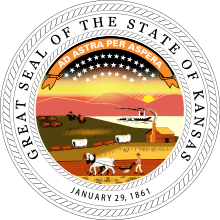Norton County, Kansas
| Norton County, Kansas | |
|---|---|
| County | |
|
Norton County Courthouse in Norton | |
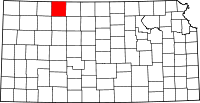 Location in the U.S. state of Kansas | |
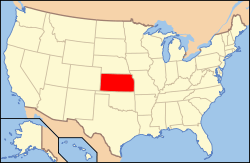 Kansas's location in the U.S. | |
| Founded | February 26, 1867 |
| Named for | Orloff Norton |
| Seat | Norton |
| Largest city | Norton |
| Area | |
| • Total | 881 sq mi (2,282 km2) |
| • Land | 878 sq mi (2,274 km2) |
| • Water | 3.2 sq mi (8 km2), 0.4% |
| Population (est.) | |
| • (2016) | 5,493 |
| • Density | 6.5/sq mi (2.5/km2) |
| Congressional district | 1st |
| Time zone | Central: UTC−6/−5 |
| Website | NortonCounty.org |
Norton County (standard abbreviation: NT) is a county located in the U.S. state of Kansas. As of the 2010 census, the county population was 5,671.[1] The largest city and county seat is Norton.[2] The county was established in 1867 and named for Orloff Norton, captain of Company L, 15th Kansas Militia Infantry Regiment.[3]
History
Early history
For many millennia, the Great Plains of North America was inhabited by nomadic Native Americans. From the 16th century to 18th century, the Kingdom of France claimed ownership of large parts of North America. In 1762, after the French and Indian War, France secretly ceded New France to Spain, per the Treaty of Fontainebleau.
19th century
In 1802, Spain returned most of the land to France, but keeping title to about 7,500 square miles. In 1803, most of the land for modern day Kansas was acquired by the United States from France as part of the 828,000 square mile Louisiana Purchase for 2.83 cents per acre.
In 1854, the Kansas Territory was organized, then in 1861 Kansas became the 34th U.S. state. Norton County was founded by Noah H. Billings, Thomas Beaumont, Henry Gordon, P. Hansen, and George Cole on August 22, 1872. In 1878 Norton became the county seat. The county gets its name for Civil War soldier Orloff Norton, who was killed at Cane Hill, Arkansas in 1864.
The first county fair, although not official, was held in Leota in October, 1878. After 1900 the fair was held yearly in Elmwood Park in Norton. The first school district was formed in Norton in 1872. School was held in a dugout beginning December 1, 1873.
Geography
According to the U.S. Census Bureau, the county has a total area of 881 square miles (2,280 km2), of which 878 square miles (2,270 km2) is land and 3.2 square miles (8.3 km2) (0.4%) is water.[4]
Adjacent counties
- Furnas County, Nebraska (north)
- Harlan County, Nebraska (northeast)
- Phillips County (east)
- Graham County (south)
- Sheridan County (southwest)
- Decatur County (west)
Demographics
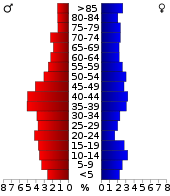
| Historical population | |||
|---|---|---|---|
| Census | Pop. | %± | |
| 1880 | 6,998 | — | |
| 1890 | 10,617 | 51.7% | |
| 1900 | 11,325 | 6.7% | |
| 1910 | 11,614 | 2.6% | |
| 1920 | 11,423 | −1.6% | |
| 1930 | 11,701 | 2.4% | |
| 1940 | 9,831 | −16.0% | |
| 1950 | 8,808 | −10.4% | |
| 1960 | 8,035 | −8.8% | |
| 1970 | 7,279 | −9.4% | |
| 1980 | 6,689 | −8.1% | |
| 1990 | 5,947 | −11.1% | |
| 2000 | 5,953 | 0.1% | |
| 2010 | 5,671 | −4.7% | |
| Est. 2016 | 5,493 | [5] | −3.1% |
| U.S. Decennial Census[6] 1790-1960[7] 1900-1990[8] 1990-2000[9] 2010-2016[1] | |||
As of the 2000 US census, there were 5,953 people, 2,266 households, and 1,470 families residing in the county. The population density was 7 people per square mile (3/km²). There were 2,673 housing units at an average density of 3 per square mile (1/km²). The racial makeup of the county was 93.35% White, 4.05% Black or African American, 0.44% Native American, 0.42% Asian, 0.02% Pacific Islander, 1.02% from other races, and 0.71% from two or more races. 2.37% of the population were Hispanic or Latino of any race.
There were 2,266 households out of which 28.20% had children under the age of 18 living with them, 55.50% were married couples living together, 7.00% had a female householder with no husband present, and 35.10% were non-families. 32.30% of all households were made up of individuals and 17.90% had someone living alone who was 65 years of age or older. The average household size was 2.28 and the average family size was 2.89.
In the county, the population was spread out with 22.00% under the age of 18, 7.70% from 18 to 24, 28.30% from 25 to 44, 22.30% from 45 to 64, and 19.60% who were 65 years of age or older. The median age was 40 years. For every 100 females there were 122.10 males. For every 100 females age 18 and over, there were 122.90 males.
The median income for a household in the county was $31,050, and the median income for a family was $37,036. Males had a median income of $25,983 versus $20,381 for females. The per capita income for the county was $16,835. About 6.10% of families and 10.50% of the population were below the poverty line, including 12.70% of those under age 18 and 8.20% of those age 65 or over.
Government
County
Noah H. Billings was an early county settler, county superintendent of schools, county attorney, and state representative. Keith Sebelius served as a U.S. congressman from 1969 to 1981.[10]
Presidential elections
| Year | Republican | Democratic | Third Parties |
|---|---|---|---|
| 2016 | 82.4% 1,840 | 12.6% 281 | 5.1% 113 |
| 2012 | 80.8% 1,878 | 17.1% 398 | 2.1% 49 |
| 2008 | 77.8% 1,878 | 20.6% 497 | 1.7% 40 |
| 2004 | 80.5% 2,092 | 18.2% 473 | 1.3% 34 |
| 2000 | 71.2% 1,744 | 24.4% 598 | 4.5% 109 |
| 1996 | 66.4% 1,814 | 23.4% 640 | 10.1% 277 |
| 1992 | 47.9% 1,469 | 25.4% 779 | 26.7% 820 |
| 1988 | 67.5% 1,923 | 30.0% 855 | 2.4% 69 |
| 1984 | 79.2% 2,515 | 19.2% 611 | 1.6% 50 |
| 1980 | 75.5% 2,625 | 19.2% 666 | 5.4% 186 |
| 1976 | 60.6% 2,201 | 36.8% 1,337 | 2.7% 97 |
| 1972 | 75.8% 2,688 | 21.9% 776 | 2.3% 82 |
| 1968 | 70.9% 2,543 | 23.5% 841 | 5.6% 202 |
| 1964 | 60.1% 2,245 | 38.8% 1,449 | 1.1% 42 |
| 1960 | 68.0% 2,781 | 31.8% 1,300 | 0.2% 8 |
| 1956 | 71.6% 3,052 | 28.0% 1,194 | 0.4% 18 |
| 1952 | 76.2% 3,530 | 22.6% 1,047 | 1.2% 54 |
| 1948 | 61.0% 2,461 | 35.0% 1,414 | 4.0% 161 |
| 1944 | 70.9% 2,890 | 28.4% 1,159 | 0.7% 29 |
| 1940 | 70.3% 3,415 | 28.4% 1,378 | 1.4% 66 |
| 1936 | 54.8% 2,829 | 44.7% 2,307 | 0.5% 24 |
| 1932 | 44.2% 2,272 | 52.6% 2,705 | 3.3% 168 |
| 1928 | 74.0% 3,365 | 23.9% 1,087 | 2.1% 96 |
| 1924 | 59.3% 2,778 | 26.9% 1,261 | 13.7% 643 |
| 1920 | 65.2% 2,288 | 30.9% 1,082 | 3.9% 137 |
| 1916 | 34.3% 1,616 | 61.0% 2,876 | 4.7% 222 |
| 1912 | 24.0% 598 | 43.3% 1,081 | 32.7% 815 |
| 1908 | 49.8% 1,448 | 46.0% 1,337 | 4.3% 125 |
| 1904 | 67.2% 1,570 | 17.8% 417 | 15.0% 350 |
| 1900 | 51.7% 1,329 | 47.1% 1,212 | 1.2% 31 |
| 1896 | 42.1% 941 | 56.3% 1,260 | 1.6% 36 |
| 1892 | 48.3% 1,054 | 51.7% 1,130[lower-alpha 1] | |
| 1888 | 56.6% 1,471 | 24.3% 631 | 19.1% 497 |
Like all the High Plains, Norton County is overwhelmingly Republican. In 1964, the last time the Republicans did not carry Kansas’ electoral votes, Norton County was Barry Goldwater’s second-best county in the state behind Clay County. The last Democrat to reach forty percent of the county’s vote was Franklin D. Roosevelt in 1936, ironically against Kansas Governor Alf Landon. Roosevelt in 1932 was the last Democrat to carry Norton County, and the only others are Woodrow Wilson (twice) and William Jennings Bryan in his first 1896 campaign.
Laws
Following amendment to the Kansas Constitution in 1986, the county remained a prohibition, or "dry", county until 1992, when voters approved the sale of alcoholic liquor by the individual drink with a 30 percent food sales requirement.[12]
Education
Unified school districts
- Norton Community USD 211
- Northern Valley USD 212
- northeastern portion of county, all east of US 283 and north of US 36; extends into northwestern Phillips County
- West Solomon USD 213 (elementary school only; students in grades 6-12 attend schools in Norton)
Communities
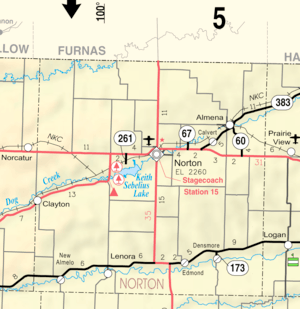
Cities
Townships
Norton County is divided into four townships. The city of Norton is considered governmentally independent and is excluded from the census figures for the townships. In the following table, the population center is the largest city (or cities) included in that township's population total, if it is of a significant size. The 2010 census shows the area of the former Harrison-District 6 as combined into that of Almena-District 4.
| Township | FIPS | Population center |
Population | Population density /km² (/sq mi) |
Land area km² (sq mi) | Water area km² (sq mi) | Water % | Geographic coordinates |
|---|---|---|---|---|---|---|---|---|
| Almena-District 4 | 01450 | 614 | 2 (6) | 278 (107) | 0 (0) | 0% | 39°53′10″N 99°41′2″W / 39.88611°N 99.68389°W | |
| Center-District 1 | 12260 | 1,382 | 2 (5) | 654 (253) | 0 (0) | 0.08% | 39°53′43″N 99°57′2″W / 39.89528°N 99.95056°W | |
| Harrison-District 6 (defunct[13]) | 30460 | 12 | 0 (0) | 93 (36) | 0 (0) | 0.02% | 39°56′54″N 99°48′25″W / 39.94833°N 99.80694°W | |
| Highland-District 2 | 32060 | 737 | 1 (3) | 748 (289) | 9 (3) | 1.13% | 39°41′24″N 100°1′49″W / 39.69000°N 100.03028°W | |
| Solomon-District 3 | 66410 | 196 | 0 (1) | 496 (192) | 0 (0) | 0.02% | 39°40′38″N 99°45′56″W / 39.67722°N 99.76556°W |
See also
|
|
References
- 1 2 "State & County QuickFacts". United States Census Bureau. Archived from the original on July 15, 2011. Retrieved July 27, 2014.
- ↑ "Find a County". National Association of Counties. Retrieved 2011-06-07.
- ↑ Blackmar, Frank Wilson (1912). Kansas: A Cyclopedia of State History, Volume 2. Standard Publishing Company. p. 374.
- ↑ "US Gazetteer files: 2010, 2000, and 1990". United States Census Bureau. 2011-02-12. Retrieved 2011-04-23.
- ↑ "Population and Housing Unit Estimates". Retrieved June 9, 2017.
- ↑ "U.S. Decennial Census". United States Census Bureau. Retrieved July 27, 2014.
- ↑ "Historical Census Browser". University of Virginia Library. Retrieved July 27, 2014.
- ↑ "Population of Counties by Decennial Census: 1900 to 1990". United States Census Bureau. Retrieved July 27, 2014.
- ↑ "Census 2000 PHC-T-4. Ranking Tables for Counties: 1990 and 2000" (PDF). United States Census Bureau. Retrieved July 27, 2014.
- ↑ Norton County, Kansas, Kansas Historical Society
- ↑ http://uselectionatlas.org/RESULTS
- ↑ "Map of Wet and Dry Counties". Alcoholic Beverage Control, Kansas Department of Revenue. November 2006. Archived from the original on 2007-10-08. Retrieved 2007-12-26.
- ↑ Kansas State Historical Society
- Notes
- ↑ 1,090 votes (49.91%) were for Populist James B. Weaver (who was supported by the state’s Democrats) and 40 (1.83%) for Prohibition Party candidate John Bidwell.
Further reading
- Standard Atlas of Marion County, Kansas; Geo. A. Ogle & Co; 71 pages; 1917.
External links
| Wikimedia Commons has media related to Norton County, Kansas. |
- County
- Maps
